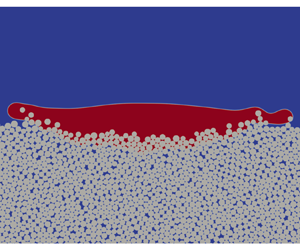Article contents
Coupled lattice Boltzmann method–discrete element method model for gas–liquid–solid interaction problems
Published online by Cambridge University Press: 20 November 2023
Abstract

In this paper, we propose a numerical model to simulate gas–liquid–solid interaction problems, coupling the lattice Boltzmann method and discrete element method (LBM–DEM). A cascaded LBM is used to simulate the liquid–gas flow field using a pseudopotential interaction model for describing the liquid–gas multiphase behaviour. A classical DEM resorting to fictitious overlaps between the particles is used to simulate the multiple-solid-particle system. A multiphase fluid–solid two-way coupling algorithm between LBM and DEM is constructed. The model is validated by four benchmarks: (i) single disc sedimentation, (ii) single floating particle on a liquid–gas interface, (iii) sinking of a horizontal cylinder and (iv) self-assembly of three particles on a liquid–gas interface. Our simulations agree well with the numerical results reported in the literature. Our proposed model is further applied to simulate droplet impact on deformable granular porous media at pore scale. The dynamic droplet spreading process, the deformation of the porous media (composed of up to 1277 solid particles) as well as the invasion of the liquid into the pores are well captured, within a wide range of impact Weber number. The droplet spreading dynamics on particles is analysed based on the energy budget, which reveals mechanisms at play, showing the evolution of particle energy, surface energy and viscous dissipation energy. A scaling relation based on the impact Weber number is proposed to describe the maximum spreading ratio.
Information
- Type
- JFM Papers
- Information
- Copyright
- © The Author(s), 2023. Published by Cambridge University Press.
References
Fei et al. Supplementary Movie 1
Droplet impact on a deformable porous medium at Re=240 and We=4.4 with contact angle θ=90°.
Fei et al. Supplementary Movie 2
Droplet impact on a deformable porous medium at Re=240 and We=4.4 with contact angle θ=60°.
Fei et al. Supplementary Movie 3
Droplet impact on a deformable porous medium at Re=240 and We=33.6 with contact angle θ=90°.
Fei et al. Supplementary Movie 4
Droplet impact on a deformable porous medium at Re=240 and We=33.6 with contact angle θ=60°.
Fei et al. Supplementary Movie 5
Droplet impact on a deformable porous medium at Re=240 and We=151.3 with contact angle θ=90°.
- 17
- Cited by


